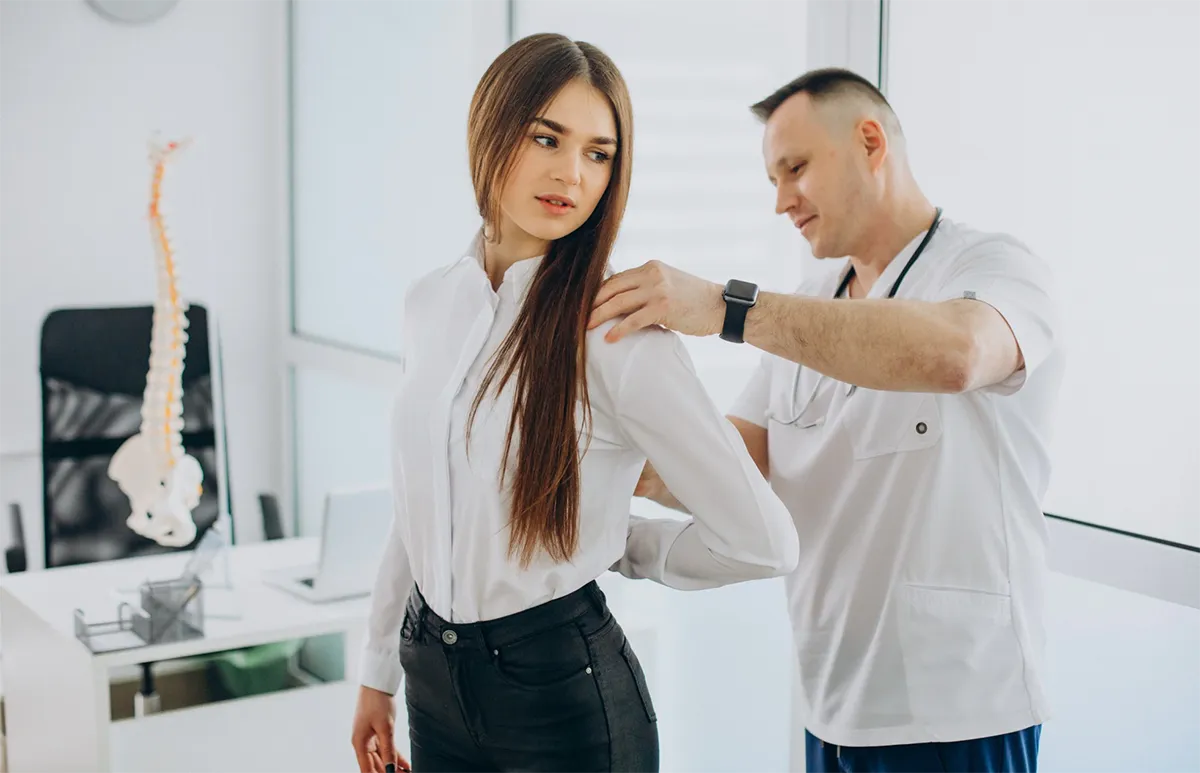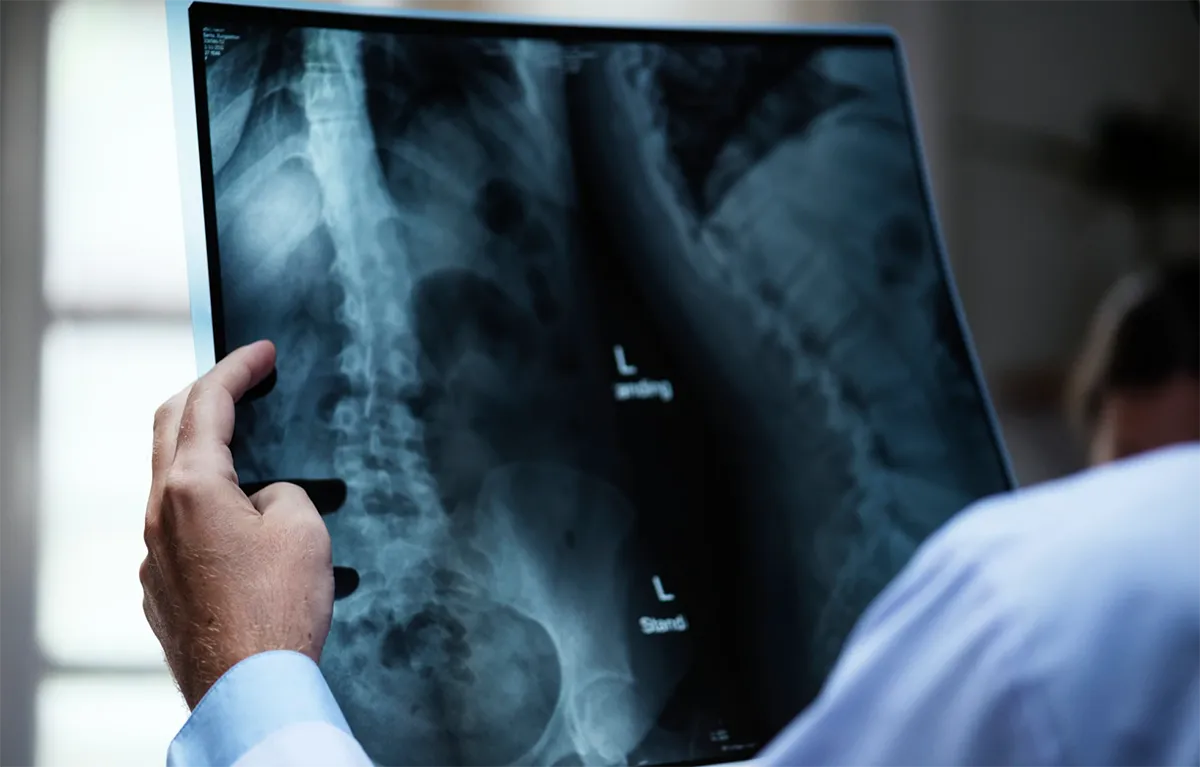Learn More About Scoliosis Research Studies
What Are Scoliosis Clinical Trials?
Scoliosis is a flexible or rigid deformity of the spine that consists of lateral curvature and rotation of the vertebrae. Although scoliosis may occur in patients with muscular dystrophy and cerebral palsy, researchers don’t currently know the primary cause of scoliosis. Most cases of scoliosis are mild. Although most cases of scoops are relatively minor, some curvatures get worse with time. In severe cases, the curvature could result in a disability that may require long term care and rehabilitation.
Severe spinal curves can compress the space within the chest cavity and disrupt lung function. Patients with mild scoliosis have to be monitored on a regular basis with X rays to see how the curvature is evolving. Some patients, especially children, may have to wear braces to prevent the curve from getting worse. Surgery may be used to lessen the curve in the spine. Scoliosis research studies are currently focused on understanding disease pathophysiology and identifying clear causes.

Researchers currently divide scoliosis curves into two categories: structural and nonstructural. In structural scoliosis, the curvature of the spine is rigid and cannot be reversed. In nonstructural scoliosis, the spine retains normal function but looks curbed. This may happen due to a limb length discrepancy when one leg is hotter than the other leg. Scoliosis clinical trials are investigating the use of gene therapy to develop non-invasive spine fusion techniques that could replace spinal fusion surgery. In some cases, gene therapy may eliminate the need for surgery.
Why Is Scoliosis Being Studied Through Clinical Trials?
Scoliosis research studies are being used to develop novel drug therapies with the aim of replacing spinal fusion surgery. More specifically, researchers are investigating gene therapy and other new approaches for treating severe scoliosis. The primary cause of scoliosis is currently unknown and, as a consequence, it has no cure.
Researchers have identified various factors, injuries to the spine, birth defects, and certain neuromuscular conditions for causing the deformity. It is not believed to be linked with bad posture, diet, or exercise. Further scoliosis research studies are needed to improve the quality of life for patients and prevent disability.
What Are The Types of Treatments Available For Scoliosis?
Treatment for scoliosis largely depends on the patient’s symptoms as well as the extent of curvature. Patients with mild curves do not need treatment, but they may be asked to undergo regular check ups to monitor the progression of the curvature. Severe cases of spinal curvature require bracing or surgery.
Health practitioners evaluate a number of factors before prescribing treatments, including the patient's age, the severity of the curvature, and gender. For example, children who have completed their growth spurt have a lower risk of curve progression. The use of braces can have an impact on children who are still growing. X-rays may be used to check bone maturity. Females have been found to have a much higher risk of curve progression compared to males.

Braces may be recommended to patients if their bones are still growing. A brace does not cure scoliosis but prevents the curve from getting progressively worse. Most braces are made from plastic and are custom designed to fit the body. Many patients opt to wear braces that appear invisible to become less conspicuous in crowds. Braces are commonly worn for up to 16 hours a day.
Surgery is used as a last resort option when scoliosis gets worse. The most common surgical options include spinal fusion and vertebral body tethering. Spinal fusion is a procedure where the surgeon connects two or more bones in the vertebrate to increase its rigidity. This is done by inserting bone-like materials between the vertebrae. Metal rods and screws are used to hold part of the spine straight to allow the old and new bone materials to fuse together.
Vertebral body tethering is a procedure where surgeons make small incisions to insert screws on the outside edge of the spinal curve. A durable yet flexible cord is threaded through these screws. This is done to straighten the spine.
What Are Some Recent Breakthrough Clinical Trials For Scoliosis?
Scoliosis clinical trials help health practitioners identify the primary causes of the disease, risk factors, and develop novel treatments. The emphasis of most research studies is to find non-surgical methods for improving the symptoms of scoliosis. Below are major breakthrough studies that may improve the quality of life for patients with scoliosis.
2018: Body Awareness Therapy in Adolescents with Idiopathic Scoliosis - This clinical trial aimed to study the effect of body awareness therapy on trunk asymmetry, curve magnitude, cosmetic deformity, QoL metrics in adolescent participants with idiopathic scoliosis. 20 female patients were randomly assigned to the Basic Body Awareness Therapy (BBAT) group or the traditional exercises (TE) group. The BBAT group received both BBAT and traditional exercises, while the TE group only received traditional exercises.
It was found that the BBAT group showed significant improvement in Cobb angle than the TE group. Cosmetic deformity improved in both groups with a similar score, although the BBAT group showed improvements in body asymmetry. Quality of life scores was similar in both groups. This study suggests that BBAT can be used to complement TETs and bracing with great results.
2019: Operative vs. Nonoperative Treatment for SL Scoliosis - This randomized controlled trial investigated the efficacy of operative procedures with nonoperative treatment in adult participants with lumbar scoliosis. Patients (aged 40 to 80 years) with an Oswestry Disability Index score of ≥20, SRS-22 score of less than 4, and a Cobb angle measurement ≥30° were randomized into two groups: one receiving operative treatment and the other receives nonoperative treatment.
The end point was the differences in the mean change from baseline in the SRS 22 subscore and ODI at 2 year follow up. It was found that operative treatment was associated with superior results at the 2 year follow up in the SRS 22 subscore. Surgery in the operative care group was superior on the basis of their SRS 22 subscore. Overall, more patients that received operative treatment achieved significant clinical improvements.
2019: Muscle Stretching and Maintaining Posture in Females with Scoliosis - This randomized controlled trial investigated the use of prior muscle stretching on posture training in female adolescents with AIS. 18 participants with AIS were randomized into two groups: Group A with a stretching protocol and Group B with no stretching before performing posture maintenance exercise.
It was found that prior muscle stretching had a negative effect on posture exercises. This indicates that patients should avoid stretching before posture maintenance exercises.
2019: Core Stabilization Exercises vs. Scoliosis-specific Exercises - This randomized clinical trial compared the efficacy of scoliosis-specific exercises with generic exercise methods for rehabilitating patients with scoliosis. 30 adolescent females with a moderate curve of between 20° to 45° were randomized into two groups. One group performed various core stabilization exercises and the other performed scientific exercises based on scoops therapy.
The endpoints were measured using an angle of trunk rotation, Cobb angle, cosmetic trunk deformity, quality of life, and body symmetry. Both groups saw a marked improvement in thoracic and lumbar Cobb angles, body symmetry, as well as cosmetic trunk deformity. There were no changes observed in the quality of life metrics. The study found that scoliosis-specific exercises and core stability exercises had similar effects in treating patients with moderate scoliosis.
2020: Fibrinogen Concentrate During Scoliosis Surgery - This randomized controlled trial investigated the use of fibrinogen during scoliosis surgery 102 participants were randomly allocated to receive intraoperative fibrinogen concentrate and saline placebo. It was found that fibrinogen reduced perioperative blood loss by an average volume of 155 ml.
Although the use of fibrinogen concentrate in scoliosis surgery yields promising results, further trials are needed to fully understand the impact of fibrinogen concentrate to allow any recommendations to be made.
2021: Effectiveness of Exercise Approaches in Idiopathic Scoliosis - This randomized controlled trial compared the efficacy of Schroth exercises with core stabilization exercises. 28 adolescent. Participants were randomized to two groups: the Schroth group and the core group. Participants in the Schroth group were coached with Schroth exercises and the participants in the core group underwent core stabilization exercises. Both groups performed the exercise three days every week for 10 weeks.
End points were measured using the WRVA scale, Spinal Mouse, Adams’s Test, and peripheral muscle strength. Participants were asked to complete a QoL questionnaire (Scoliosis Research Society 22). It was found that Schroth exercises significantly improved Cobb angles, cosmetic trunk deformity, spinal mobility, and QoL metrics compared to the core group.
2021: Foot Posture and Walking Performance in Patients with AIS - This clinical trial compared the walking performance and foot posture in adolescents with idiopathic scoliosis and compared them with their healthy peers. 96 adolescents were enrolled in the study in China, with 64 patients in the AIS group and 32 participants in the control group. Researchers analyzed plantar pressure distribution, foot posture and morphology, and gait.
It was found that moderate and severe idiopathic scoliosis impacted walking performance. However, researchers didn’t find any major differences between adolescents with mild AIS and the control group. The study concluded that early intervention could play an important role in preventing scoliosis from progressing to a severe state.
Who Are Some Of The Key Researchers and Institutions Conducting Scoliosis Clinical Trial Research?
Spine & Scoliosis Center, Delaware Valley, is a leading research institute that has helped over 3,000 adolescents with scoliosis. Their researchers are focused on developing non-surgical solutions for correcting severe spine issues in children. The emphasis is on making fewer incision cuts and reducing hospital stays to improve the quality of life outcomes for patients. The healthcare center is led by Dr. Suken A. Shah, the vice chair of the Department of Orthopedic Surgery, who has been an orthopedic surgeon for 20 years.
Miller Scoliosis Lab Research at the University of Colorado utilizes results from clinical trials to broaden the understanding of idiopathic scoliosis. Their research dates back several decades and is largely focused on complex molecular interactions that can help with early diagnosis, prevention, and treatment modalities for people with idiopathic scoliosis.
Suken A. Shah. MD is one of the foremost authorities in scoliosis research studies. He is the Division Chief of Spine and Scoliosis Service and Clinical Fellowship Director at Nemours. He attended Thomas Jefferson University for orthopedic training and Alfred I. DuPont Hospital for fellowship training. He is a member of the Board of Directors of the Scoliosis Research Society and also serves as chair of their Program Committee.